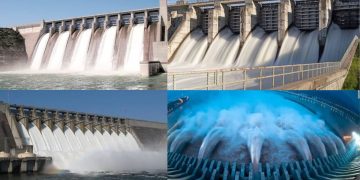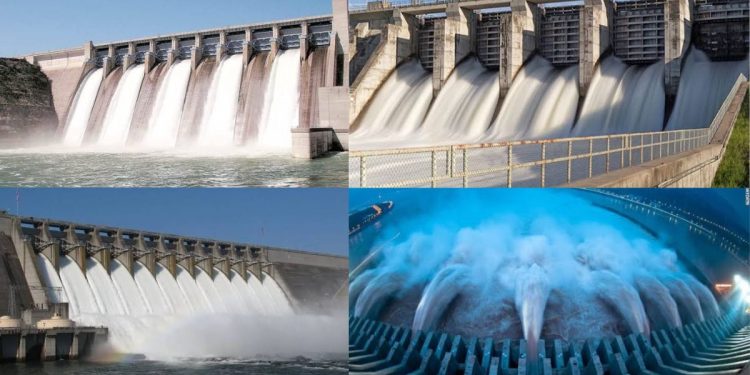Nigeria is the giant of Africa yet she still struggles with short power generation thereby causing epileptic power supply in most regions of the federation. However, Nigeria has many hydro power plants scattered around almost every state of the federation yet it cannot boast of steady power supply.
There are some regions of this country that stay months without power supply and have resulted in using other means of power supply but there’s no doubt that it affects the cost of living, doing business and it has seen a sporadic high cost of service delivery.
In this article, we will be listing some power plants in the country and generating capacity which, if revitalized, can rescue the nation from its epileptic power supply.
1. KAINJI POWER STATION:
Kainji Dam is a dam across the Niger River in Niger State of Central Nigeria. Construction of the dam was carried out by Impregilo (a consortium of Italian Civil Engineering Contractors) to designs by Joint Consultants, Balfour Beatty and Nedeco, and began in 1964 to be completed in 1968. The total cost was estimated at US$209 million (equivalent to about US$1.3 billion in 2020 dollars), with one-quarter of this amount used to resettle people displaced by the construction of the dam and its reservoir, Kainji Lake.
Kainji Dam extends for about 10 kilometres (6.2 mi), including its saddle dam, which closes off a tributary valley. The primary section across the outflow to the Niger is 550 metres (1,800 ft). Most of the structure is made from earth, but the centre section, housing the hydroelectric turbines, was built from concrete. This section is 65 metres (213 ft) high. Kanji Dam is one of the longest dams in the world.
The dam was designed to have a generating capacity of 960 megawatts (1,290,000 hp); however, only 8 of its 12 turbines have been installed, reducing the capacity to 760 megawatts (1,020,000 hp). The dam generates electricity for all the large cities in Nigeria. Some of the electricity is sold to the neighbouring country of Niger. In addition, occasional droughts have made Niger’s water flow unpredictable, diminishing the dam’s electrical output.
2. JEBBA POWER STATION:
The Jebba Hydroelectric Power Station, also Jebba Power Station, is a hydroelectric power plant across the Niger River in Nigeria. It has a power generating capacity of 578.4 megawatts, enough to power over 364,000 homes. The plant was commissioned on 13 April 1985, although commercial energy production began in 1983.
The Jebba Power Station is located about 100 kilometres (62 mi) downstream of the Kainji Dam, and approximately 40 kilometres (25 mi) southwest of Mokwa, the nearest urban centre.
This is approximately 256 kilometres (159 mi) by road, southwest of Minna, the capital of Niger State. The power station sits astride the Niger River at the border between Niger State and Kwara State, approximately 91.5 kilometres (57 mi), by road, northeast of Ilorin, the capital city of Kwara State. Jebba Dam sits at an elevation of 71.917 metres (236 ft) above mean sea level.
The power station, owned by the Federal Government of Nigeria comprises six generation turbines, each with a rated capacity of 96.4 megawatts, for a maximum installed output of 578.4 megawatts. The concession agreement for operations and maintenance at this power station is held by Mainstream Energy Solutions Limited, an independent power company.
3. SHIRORO POWER PLANT:
The Shiroro Power Station is a hydroelectric power plant of the Kaduna River in Niger State, Nigeria. It has a power generating capacity of 600 megawatts (800,000 hp) enough to power over 404,000 homes.
The Shiroro Power Station began operating in 1990.
4. TRANSCORP UGHELLI POWER STATION:
It is the largest fossil-fuel based power generating station in the country located in Ughelli, Delta state. The plant has installed capacity of 972 MW; and is capable of generating 2500 GWh of electricity annually.
Most of the electricity produced by Ughelli is transported through a network of conductors, to the national grid. The refurbishment of existing power units and the addition of a new 400 MW project are likely to drive a 4x increase in revenue to NGN100 billion by 2020. The plant is an asset of Transnational Corporation of Nigeria Plc (Transcorp)’s power subsidiary, Transcorp Ughelli Power Limited.
The station was built in 1964 with an installed capacity of 2X36MW or 72MW from two Stal-Laval gas turbines and began operations in 1966. Then the station was called Delta I under the Electricity Corporation of Nigeria (ECN), a precursor to the Nigerian Electric Power Authority (NEPA) and its successor, the Power Holding Company of Nigeria (PHCN).
5. DADIN KOWA POWER STATION:
The Dadin Kowa Dam is in Yamaltu local government area of Gombe State, Nigeria. The dam is located about 35 kilometers to the east of Gombe town, and provides drinking water for the town. The dam was completed by the federal government in 1984, with the goal of providing irrigation and electricity for the planned Gongola sugar plantation project.
The reservoir has a capacity of 800 million cubic meters of water and a surface area of 300 square kilometers, and has potential as a source of fish. 26,000 people were displaced by the reservoir, receiving little assistance for resettlement.
The water supply project was built at a cost of about N8.2billion by CGC Nigeria, a Chinese company, completed during the administration of Governor Mohammed Danjuma Goje. In 2010 it was providing about 30,000 cubic meters daily, treated at a plant three kilometers from the dam before being piped to storage reservoirs in Gombe while supplying communities along the road.
6. AZURA POWER STATION:
The Azura-Edo Power Station is a natural gas-powered open cycle electricity generation plant, with a current operational capacity of 461 megawatts, located in Benin City in Nigeria. This is the first phase of a three-phase construction project of a combined cycle gas plant with planned capacity of 1,500 megawatts.
The power station is located to the northeast of Benin City in Edo State, approximately 316 kilometres (196 mi), by road, east of Lagos, Nigeria’s commercial capital. This location lies approximately 465 kilometres (289 mi), by road, southwest of Abuja, the country’s capital city.
7. IBOM POWER STATION:
Ibom Power Company Limited (IPC) is one of the first independent power plants in Nigeria. Akwa Ibom Investment Corporation (AKICORP), the investment arm of the Akwa Ibom State Government, incorporated Ibom power in 2001 as a private limited liability company under the Companies and Allied Matters Act (CAMA).
In May 2008, the company received a license from the Nigerian Electricity Regulatory Commission (NERC) to generate electricity. The license was amended to 685megawatts to accommodate both the 191megawatts Phase 1 and the proposed 500megawatts Phase 2. Ibom power receives gas from Accugas, a subsidiary of Seven Energy, based on a 10-year Gas Sales and Purchase Agreement (GSPA).
The plant output is evacuated to the national grid through a 49km 132kV transmission line from Ikot Abasi to Eket, 132/33kV substation. The Nigerian Bulk Electricity Trading Company Plc. (NBET) is the off-taker of the electricity produced by Ibom power plant.
8. EGBIN THERMAL POWER STATION:
Egbin Power Plc is the largest power generating station in Nigeria with an installed capacity of 1,320 MW consisting of 6 Units of 220MW each. The station is located at Ijede / Egbin, in Ikorodu, It is about 40 km north east of the city of Lagos, and is situated on low land in Ijede and bounded by the Lagoon to the south, Agura/Gberigbe to the north and situated in Ijede Local Council Development Area.
Egbin Thermal Power Plant, Ijede is the largest power plant in Nigeria and West Africa.
The government acquired most of the land for the project by resettling the inhabitants to Ipakan. The first unit of the plant was commissioned in July 1985,while the last was commissioned in September 1986. The station is of reheat type with high intermediate low pressure impulse reaction turbine design and a hydrogen cooled generator.
Nigeria has these number of power stations and even more but cannot boast of steady power supply and apparently none in some regions. However, there are quite a few still under construction such as Zamfara power station, Omoku Phase 1&2 power station and Mambilla hydro power station. Hopefully if usage commences, there could be an ultimate change in the power section.















